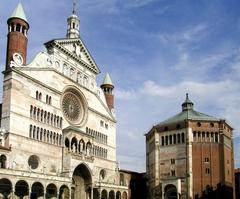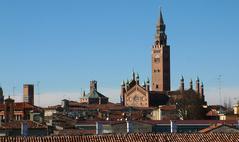Palazzo Cittanova Visiting Hours, Tickets, and Guide
Publication Date: 18/08/2024
Introduction to Palazzo Cittanova
Palazzo Cittanova stands in the heart of Cremona, Italy, as a striking monument to the city’s medieval past and civic evolution. Built in 1256, this remarkable structure arose from the ambitions of the “popolari” faction—citizens seeking independence from the aristocratic powers concentrated around the ancient Roman center. Alongside Palazzo Trecchi and the Church of Sant’Agata, the Cittanova formed the nucleus of Cremona’s urban expansion, marking a new era of social and political development (Turismo Cremona).
Showcasing a blend of Gothic and Romanesque architectural elements, the Palazzo’s facade features a two-story design with Gothic arcades on the lower level and a brick upper level adorned with merlons and four three-mullioned windows. These features signify both the building’s aesthetic value and its role as a symbol of autonomy during the 13th century (Turismo Cremona).
Throughout its history, Palazzo Cittanova has served as a center for political assemblies, cultural events, and public gatherings. Despite undergoing several restorations, it has preserved its historical and architectural integrity. Today, it remains a focal point of Cremona’s cultural life, inviting visitors to experience its storied past and vibrant present (Savoring Italy).
Contents
- History of Palazzo Cittanova
- Origins and Construction
- 13th-Century Function and Significance
- Architectural Features
- Cultural and Social Impact
- Community Role
- Restoration Efforts
- Visitor Experience
- Opening Hours
- Admission Fees
- Guided Tours
- Accessibility
- Nearby Attractions
- Dining and Accommodation
- Frequently Asked Questions
Visiting Palazzo Cittanova: History, Tickets, and Travel Tips
History of Palazzo Cittanova
Origins and Construction
Erected in 1256, Palazzo Cittanova was conceived as the heart of Cremona’s “new city,” outside the old Roman walls. This project, led by citizens aspiring to self-governance, was intended to counterbalance the influence of the ruling elite in the city’s older districts. The palace, along with nearby landmarks, became a central hub for the burgeoning neighborhood (Turismo Cremona).
The design was inspired by the municipal Town Hall, featuring a two-story brick facade. On the ground floor, a series of Gothic arcades provided shelter and a sense of openness, while the upper floor, marked by merlons and distinctive windows, was built to host important gatherings (Turismo Cremona).
13th-Century Function and Significance
During the 13th century, Palazzo Cittanova housed the Consiglio della Città Nova (“Council of the New Town”), a governing body representing the interests of Cremona’s newly empowered citizens. The palace embodied civic autonomy and served as the venue for essential administrative and social activities (Turismo Cremona).
Architectural Features
A defining feature is the square tower at the southwest corner, added in the 14th century. Originally taller and possibly used as a bell tower, it was shortened in the 16th century. The building’s facade, with its pointed arches and battlements, is characteristic of Lombard Gothic civic architecture. The four three-mullioned windows on the upper level illuminate a grand hall, reflecting both the architectural style and the social ambitions of the period (Turismo Cremona).
Internally, the ground floor was originally open, facilitating public gatherings, while the first floor features a large hall with a coffered wooden ceiling, accessible by an internal staircase (source).
Cultural and Social Impact
Community Role
Palazzo Cittanova has long been a cornerstone of Cremona’s civic life, hosting everything from political assemblies to cultural celebrations. Its ongoing use for public meetings and events preserves its status as a living monument and a center for community engagement (Savoring Italy).
Restoration Efforts
Significant restorations in the 19th and 20th centuries have ensured the building’s preservation. Efforts focused on maintaining its original Gothic features and adapting the structure for contemporary cultural use. Today, Palazzo Cittanova continues to serve as an event venue, upholding its historical role (Turismo Cremona).
Visitor Experience
Opening Hours
Palazzo Cittanova is generally open to the public from Tuesday to Sunday, 10:00 AM to 6:00 PM. However, hours may vary depending on scheduled events and exhibitions. It is advisable to consult the official website or contact the tourist office for current information (Turismo Cremona).
Admission Fees
A nominal admission fee is typically charged. Discounts are available for students, seniors, and groups. Special exhibitions or events may have separate ticketing (Turismo Cremona).
Guided Tours
Guided tours are offered in multiple languages and provide in-depth insights into the palace’s history and architecture. Reservations are recommended, especially during peak tourist seasons (Turismo Cremona).
Accessibility
The ground floor is generally accessible to visitors with reduced mobility, although access to the upper floors and tower may be limited. It is best to contact the venue ahead of your visit to discuss specific accessibility needs (Turismo Cremona).
Nearby Attractions
Located at Corso Garibaldi, 120, Palazzo Cittanova is within walking distance of Cremona’s major landmarks:
- Cremona Cathedral and Torrazzo: A short stroll from the palace, this complex is renowned for its art and architecture.
- Violin Museum: Celebrating Cremona’s rich musical heritage.
- Palazzo Trecchi and Church of Sant’Agata: Key sites from the same era (My Italian Diaries).
Dining and Accommodation
Cremona offers a diverse array of dining options, from traditional trattorias to contemporary restaurants. Visitors can choose from hotels, bed and breakfasts, and other accommodations situated conveniently near the historic center, making it easy to explore the city’s attractions (Turismo Cremona).
Frequently Asked Questions
What are the visiting hours for Palazzo Cittanova?
Palazzo Cittanova is typically open Tuesday–Sunday, 10:00 AM to 6:00 PM, but it’s best to check for updates before your visit.
How much are tickets?
There is a small admission fee, with discounts for students, seniors, and groups. Event-specific pricing may apply.
Are guided tours available?
Yes, guided tours can be booked in advance and are available in several languages.
Is the building accessible?
The ground floor is accessible; upper levels may have limited accessibility.
Can I take photos inside?
Photography policies may vary by event; it’s advisable to inquire on arrival.
Travel Tips
- Location: Corso Garibaldi, 120, Cremona
- Getting There: Easily accessible by train or car (A21 motorway). Public transport and parking are available nearby.
- Events: The palace often hosts conferences, concerts, and exhibitions. Check the event calendar for opportunities to visit the interior spaces.
Summary
Palazzo Cittanova remains a vital symbol of Cremona’s historical and cultural identity. Its origins as the heart of the “popolari” expansion, unique Gothic and Romanesque architectural features, and continuous adaptation for modern use make it a must-see for visitors interested in the heritage of Lombardy. The palace’s proximity to other major sights ensures a rich and immersive cultural experience (Turismo Cremona), (Savoring Italy), (My Italian Diaries).
Sources and Further Reading
- Turismo Cremona. Palazzo Cittanova
- Savoring Italy. Palazzo Cittanova
- My Italian Diaries. Palazzo Cittanova
- Lombardia Beni Culturali – Palazzo Cittanova
- Wikipedia (Italian) – Palazzo Cittanova
For the most current details on visiting hours, events, and tickets, visit the official website or contact Cremona’s tourist office. Enjoy your journey through the history and culture of Palazzo Cittanova!

